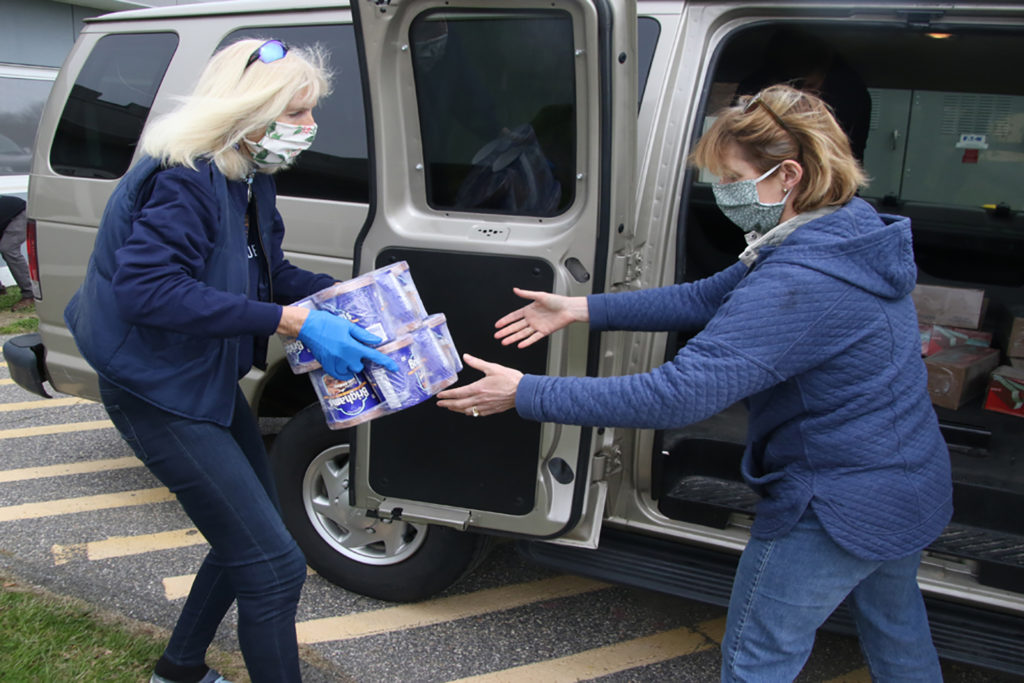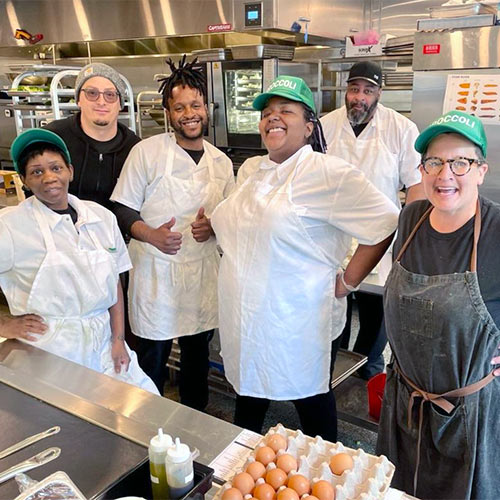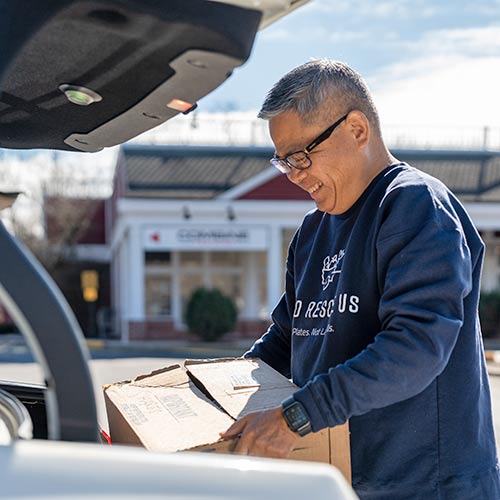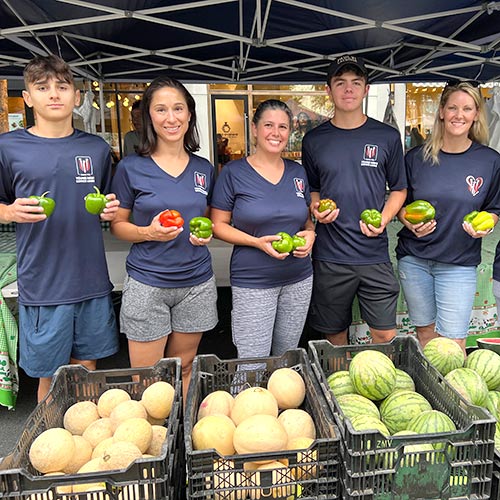Yale partners with Food Rescue US on mobile crowdsourcing study
Yale Insights – There’s a terrible irony at the center of the U.S. food system. About sixty million tons of food are thrown away every year, while more than 37 million Americans, as of 2019, didn’t have enough to eat—a figure that has only grown during the COVID-19 pandemic. So how do you get food to hungry people before it ends up in the landfill?
Before the smartphone era, it was often difficult to create systems for identifying opportunities for donating food in a timely way, even before considering the cost of transporting the donations. In recent years, however, organizations across the country have begun using mobile technology to facilitate food recovery, connecting restaurants, grocery stores, college dining halls, and other donors to recipients such as food pantries. Among these is Food Rescue US (FRUS), which uses an app to find available volunteers to complete “last mile” delivery of perishable food.
For Professor Vahideh Manshadi and PhD student Scott Rodilitz, FRUS’s work is both a vital social service and a testbed of interesting problems in data science. In 2018, they partnered with FRUS in hopes of improving the organization’s app and growing its user base. Along the way, Manshadi and Rodilitz gained new knowledge about volunteer-based crowdsourcing, described in two recent papers.
Read the studies:
- Commitment on Volunteer Crowdsourcing Platforms: Implications for Growth and Engagement
- Online Policies for Efficient Volunteer Crowdsourcing
FRUS’s app is “in the spirit of something like Uber and Lyft,” Rodilitz explains—but instead of drivers and passengers, the platform matches volunteers and available rescues. “They’re taking those sharing-economy and crowdsourcing-style innovations, and putting in them in the volunteer space and trying to do social good.”
Volunteer-based systems face unique challenges. Unlike Uber and Lyft, FRUS can’t incentivize more volunteer drivers to participate by raising the price of a rescue. To grow, the organization needs to have a well-designed system that volunteers want to use.
That means making sure that a potential volunteer who logs on to the FRUS app can find an available rescue to complete. After all, there’s no better way for an organization to deter an excited do-gooder than by telling them there’s nothing for them to do.
FRUS offers two options to volunteers: they can claim a single rescue or, since a large majority of donations recur weekly, they can adopt the rescue on an ongoing basis. Adoption is helpful to the organization, because it guarantees that certain rescues will always be completed.
Making sure all rescues are completed is a high-stakes issue for FRUS, explains Manshadi. “One of the points of pride for this organization is that they try to recover healthy, perishable foods. So if something is scheduled for today, it really needs to be picked up today.” Completing all rescues also helps FRUS maintain positive relationships with donors.
The problem with adoption of recurring rescues, however, is that it leaves fewer available rescues for new volunteers. So how do you get the balance right between adoption and one-time rescues? Which should FRUS encourage more?
In one of their papers, Manshadi and Rodilitz tackled that question, relying on data from tens of thousands of FRUS donations and thousands of volunteers. They discovered that adoption, despite its many benefits, may limit long-term growth of the volunteer base. Why? Adoption thins out the number of rescues available to a new volunteer, increasing the chances the new volunteer won’t return to the app. By limiting the number of adoptions and freeing up more rescues, FRUS can help maintain its volunteer network.
“You don’t want to get yourself into a situation where 95% of all the donations are adopted,” Manshadi says. “It’s good to have some things that are up for grabs until the last minute, because that’s your way of getting more people engaged, even though it comes with the risk of missing certain donations.”
The optimal mix of adoption and claiming, they also learned, depends on the type of community. A college town with a mostly student volunteer base will likely benefit from more last-minute claiming because students have changing, flexible schedules; a community where most volunteers are professionals with set schedules will benefit more from adoption.
Once you’ve engaged a volunteer, how often should you notify them about upcoming unclaimed rescues? Nudge too little and rescues won’t be completed, but nudge too much, and you’ll annoy volunteers—possibly causing them to delete the app. Manshadi and Rodilitz tackled this Goldilocks problem in another paper, identifying a “just-right” notification strategy.
For FRUS staff, finding volunteers to complete pending rescues is a daily challenge. Typically, site directors manually and somewhat randomly select a subset of volunteers to notify, hoping that one will respond in the available time window and complete the rescue. To avoid overburdening an unpaid workforce, site directors try to wait at least a week before notifying the same volunteer again. This notification process can take up a significant amount of time each day.
Is there a better way to solve the puzzle of notifying the right volunteers at the right time and with the right frequency? Manshadi and Rodilitz quickly realized that volunteers—even those who don’t adopt rescues on an ongoing basis—tend to follow predictable patterns. So they developed an algorithm that could detect these patterns and identify the best group of volunteers to notify on a given day. Looking for more insights?Sign up to get our top stories by email.
“What we’ve done is designed a system that takes information about historical volunteer preferences, and combines that with automated strategies for saying, ‘OK, today we think you’re best-suited for this opportunity,’” Rodilitz explains.
The algorithm doesn’t simply focus on completing today’s rescue, but also takes into account future rescues. If you have two volunteers who are both predictably available on Mondays, but only one of whom is also available on Wednesdays, the system is smart enough to “save” that volunteer for a Wednesday opportunity. “Our algorithm is forward-looking and can pick up these patterns,” says Manshadi. “That helps us do better than what’s currently happening in practice.”
Manshadi and Rodilitz plan to help FRUS implement their adoption and notification findings as soon as disruptions from the COVID-19 pandemic begin to fade. Their notification algorithm could be integrated into the organization’s app, or even delivered as a simple Microsoft Excel add-on that produces volunteer suggestions for local site directors. “At the end of the day, they know their region best,” says Manshadi. “We just want to make recommendations that hopefully help them in making decisions.”
Manshadi hopes their work can help FRUS and other food rescue organizations harness the true value of crowdsourcing. The potential to curb food waste and fight hunger is there: if many individuals set out to rescue 10 pounds of food, “before you know it, you get to millions of pounds,” she says.
She and Rodilitz also see their work as a good example of how scholars of organizations and computing can partner with nonprofits. It’s common for scholars in her field to study data-rich companies, but “now nonprofits have high-quality data about their donors and volunteers—almost the same level that Uber and Lyft have about their customers,” she says. “If researchers dedicate their attention and effort in these applications, they can make substantial improvements in nonprofit settings—and it’s very rewarding.”
In fact, she’s already at work on a new project with another organization that matches volunteers with opportunities for a variety of causes, not just food recovery. “The problems have similar flavors to what we are dealing with for FRUS,” she says.
For these organizations to grow, “you need well-designed automated systems,” she says. Without careful management, they may lose frustrated volunteers, but with it, they can thrive. “Our work shows another example of how powerful crowdsourcing can be, and also shows it needs to be designed systematically and carefully.”




